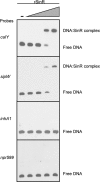Bacillus anthracis sin locus and regulation of secreted proteases
- PMID: 21131488
- PMCID: PMC3021211
- DOI: 10.1128/JB.01083-10
Bacillus anthracis sin locus and regulation of secreted proteases
Abstract
Bacillus anthracis shares many regulatory loci with the nonpathogenic Bacillus species Bacillus subtilis. One such locus is sinIR, which in B. subtilis controls sporulation, biofilm formation, motility, and competency. As B. anthracis is not known to be motile, to be naturally competent, or to readily form biofilms, we hypothesized that the B. anthracis sinIR regulon is distinct from that of B. subtilis. A genome-wide expression microarray analysis of B. anthracis parental and sinR mutant strains indicated limited convergence of the B. anthracis and B. subtilis SinR regulons. The B. anthracis regulon includes homologues of some B. subtilis SinR-regulated genes, including the signal peptidase gene sipW near the sinIR locus and the sporulation gene spoIIE. The B. anthracis SinR protein also negatively regulates transcription of genes adjacent to the sinIR locus that are unique to the Bacillus cereus group species. These include calY and inhA1, structural genes for the metalloproteases camelysin and immune inhibitor A1 (InhA1), which have been suggested to be associated with virulence in B. cereus and B. anthracis, respectively. Electrophoretic mobility shift assays revealed direct binding of B. anthracis SinR to promoter DNA from strongly regulated genes, such as calY and sipW, but not to the weakly regulated inhA1 gene. Assessment of camelysin and InhA1 levels in culture supernates from sinR-, inhA1-, and calY-null mutants showed that the concentration of InhA1 in the culture supernatant is inversely proportional to the concentration of camelysin. Our data are consistent with a model in which InhA1 protease levels are controlled at the transcriptional level by SinR and at the posttranslational level by camelysin.
Figures






Similar articles
-
Modulation of the Bacillus anthracis secretome by the immune inhibitor A1 protease.J Bacteriol. 2014 Jan;196(2):424-35. doi: 10.1128/JB.00690-13. Epub 2013 Nov 8. J Bacteriol. 2014. PMID: 24214942 Free PMC article.
-
SpoVG is an important regulator of sporulation and affects biofilm formation by regulating Spo0A transcription in Bacillus cereus 0-9.BMC Microbiol. 2021 Jun 8;21(1):172. doi: 10.1186/s12866-021-02239-6. BMC Microbiol. 2021. PMID: 34102998 Free PMC article.
-
Targets of the master regulator of biofilm formation in Bacillus subtilis.Mol Microbiol. 2006 Feb;59(4):1216-28. doi: 10.1111/j.1365-2958.2005.05019.x. Mol Microbiol. 2006. PMID: 16430695
-
Bacillus anthracis genetics and virulence gene regulation.Curr Top Microbiol Immunol. 2002;271:143-64. doi: 10.1007/978-3-662-05767-4_7. Curr Top Microbiol Immunol. 2002. PMID: 12224521 Review.
-
In vivo Bacillus anthracis gene expression requires PagR as an intermediate effector of the AtxA signalling cascade.Int J Med Microbiol. 2004 Apr;293(7-8):619-24. doi: 10.1078/1438-4221-00306. Int J Med Microbiol. 2004. PMID: 15149039 Review.
Cited by
-
A genomic region involved in the formation of adhesin fibers in Bacillus cereus biofilms.Front Microbiol. 2015 Jan 13;5:745. doi: 10.3389/fmicb.2014.00745. eCollection 2014. Front Microbiol. 2015. PMID: 25628606 Free PMC article.
-
Bacillus thuringiensis CbpA is a collagen binding cell surface protein under c-di-GMP control.Cell Surf. 2019 Aug 23;5:100032. doi: 10.1016/j.tcsw.2019.100032. eCollection 2019 Dec. Cell Surf. 2019. PMID: 32803021 Free PMC article.
-
Late-Exponential Gene Expression in codY-Deficient Bacillus anthracis in a Host-Like Environment.Curr Microbiol. 2016 Nov;73(5):714-720. doi: 10.1007/s00284-016-1120-y. Epub 2016 Aug 11. Curr Microbiol. 2016. PMID: 27515669
-
MogR Is a Ubiquitous Transcriptional Repressor Affecting Motility, Biofilm Formation and Virulence in Bacillus thuringiensis.Front Microbiol. 2020 Dec 23;11:610650. doi: 10.3389/fmicb.2020.610650. eCollection 2020. Front Microbiol. 2020. PMID: 33424814 Free PMC article.
-
Progress toward the Development of a NEAT Protein Vaccine for Anthrax Disease.Infect Immun. 2016 Nov 18;84(12):3408-3422. doi: 10.1128/IAI.00755-16. Print 2016 Dec. Infect Immun. 2016. PMID: 27647868 Free PMC article.
References
-
- Ausubel, F. M. (ed.). 1993. Current protocols in molecular biology. Greene Publishing Associates and Wiley-Interscience, New York, NY.
-
- Bai, U., I. Mandic-Mulec, and I. Smith. 1993. SinI modulates the activity of SinR, a developmental switch protein of Bacillus subtilis, by protein-protein interaction. Genes Dev. 7:139-148. - PubMed
Publication types
MeSH terms
Substances
Grants and funding
LinkOut - more resources
Full Text Sources
Other Literature Sources
Molecular Biology Databases
Research Materials

